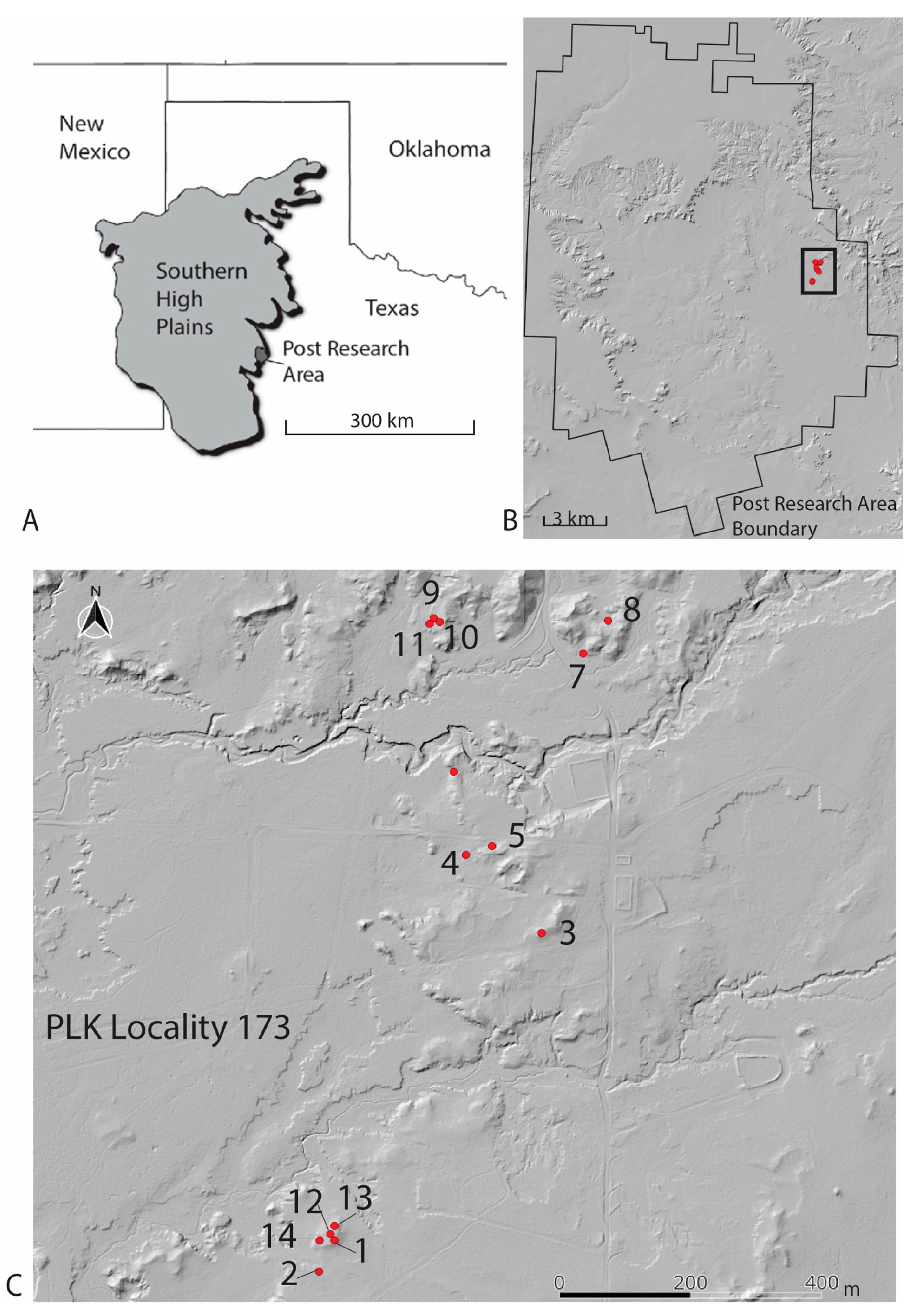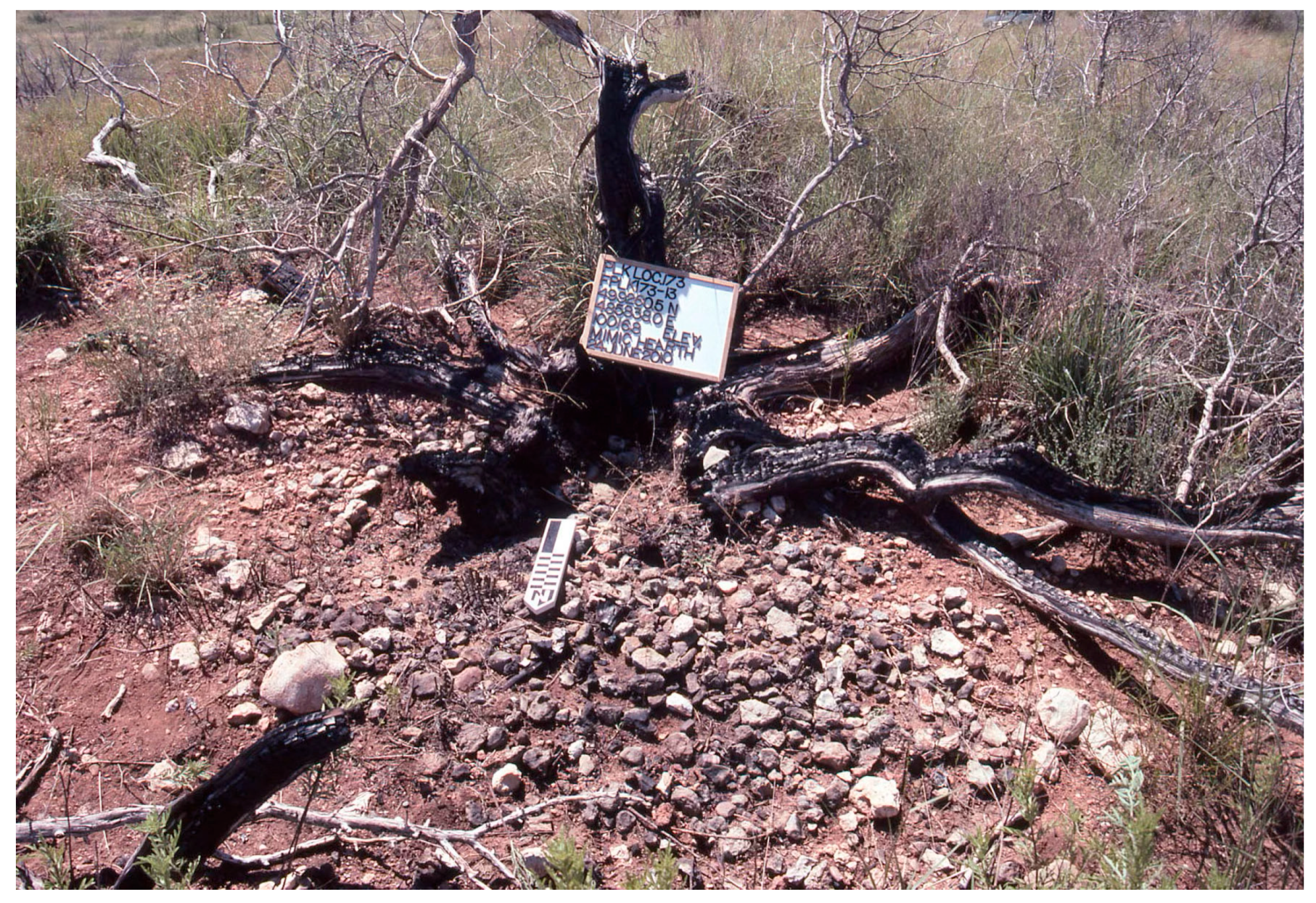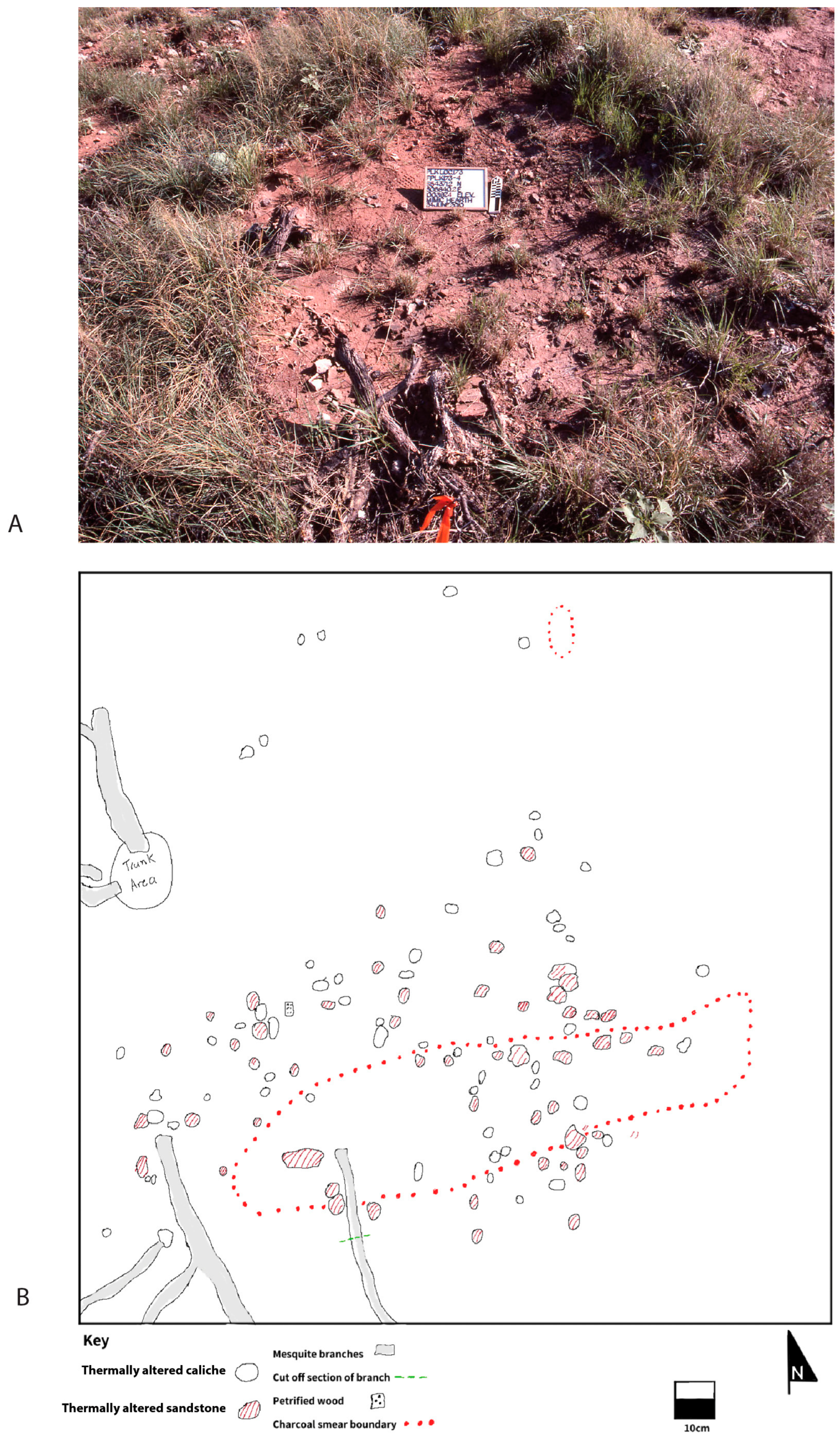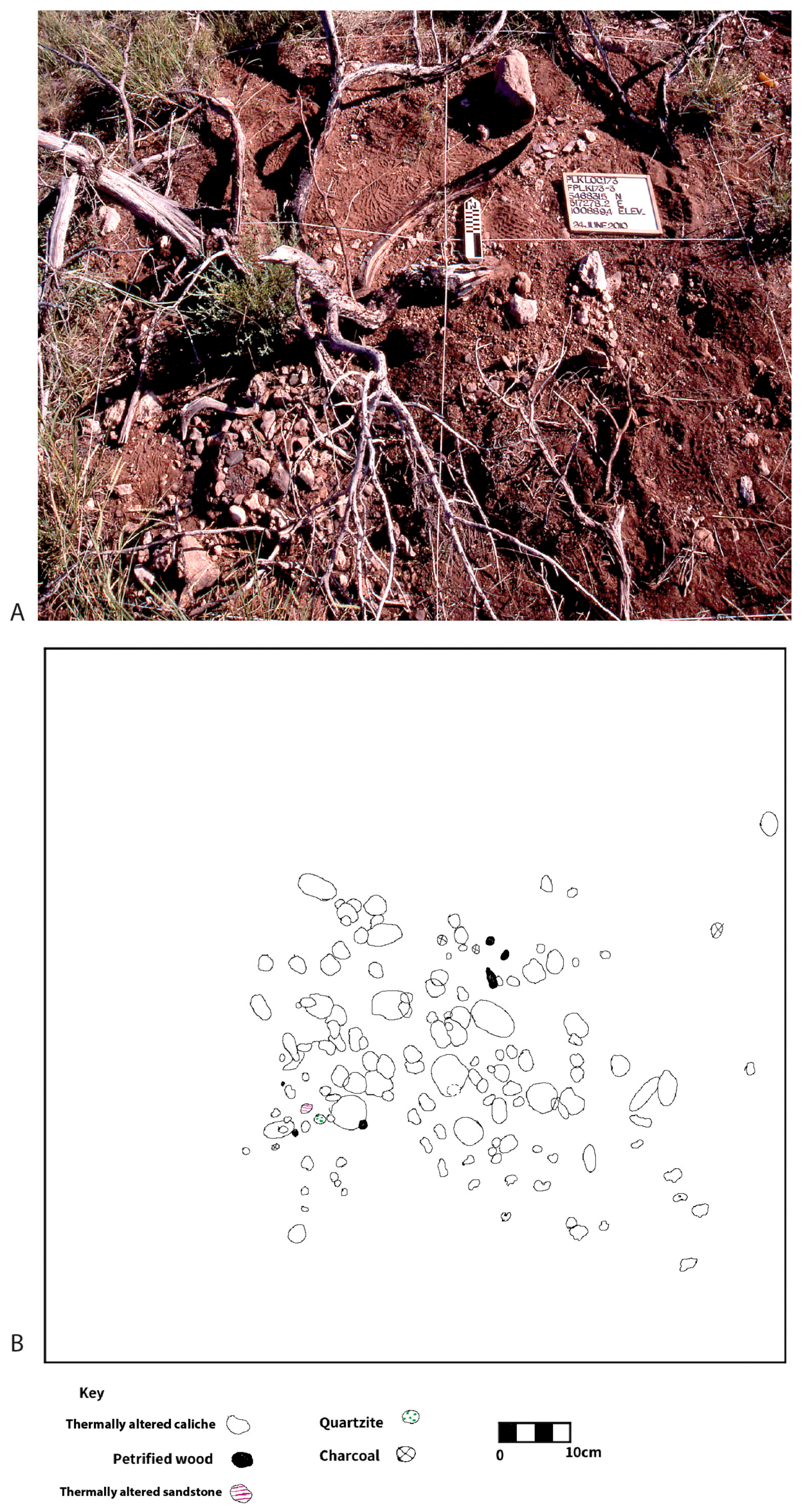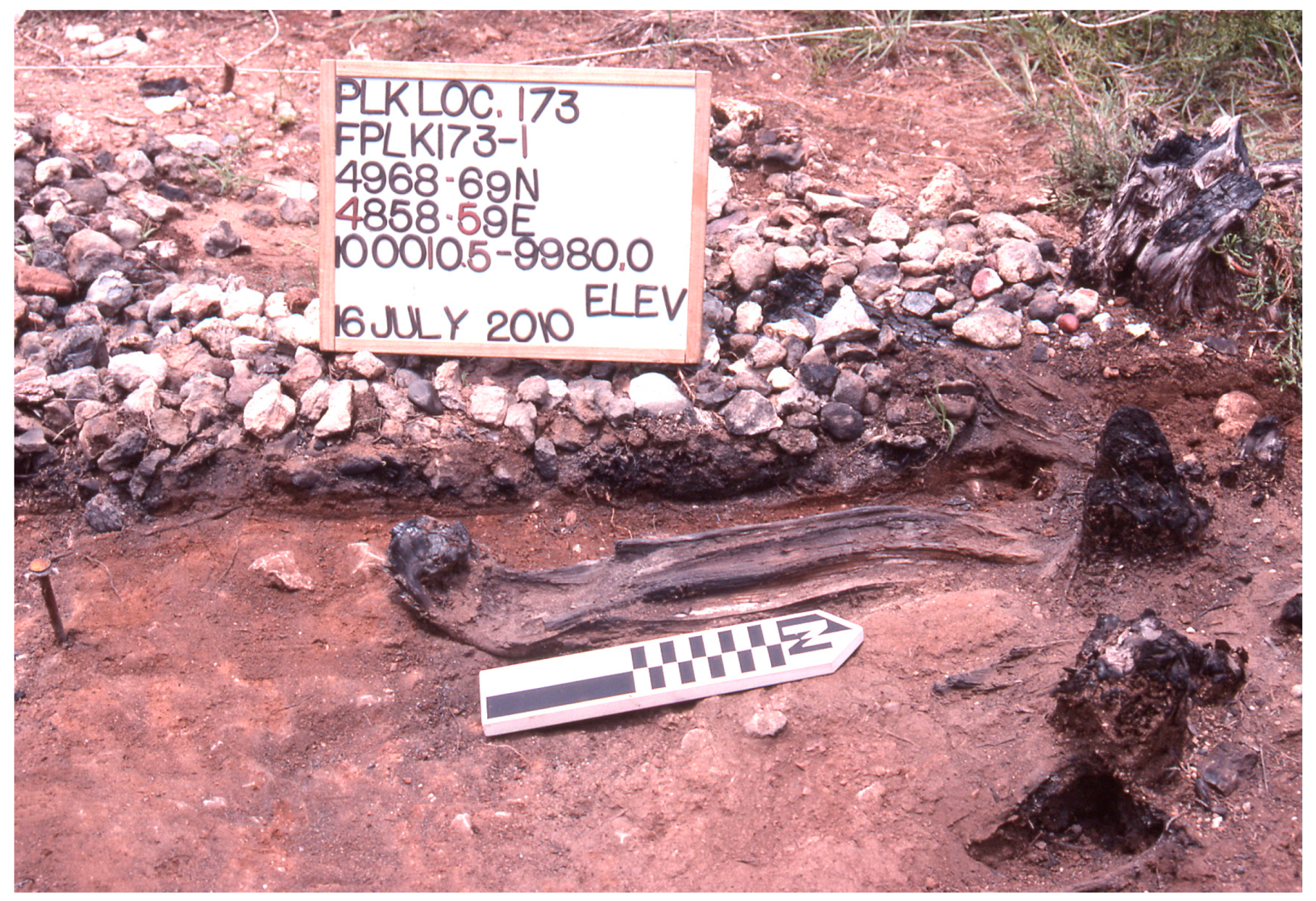1. Introduction
Anthropogenic thermal features are among the most significant archeological features on a global basis [
1,
2]. Thermal features can provide a time capsule that documents early human behavior [
3,
4,
5] and offer insights into past diet, landscape use strategies, and daily activities [
6,
7]. Surrounding rock is often used in hearths to reduce fuel consumption and moderate temperature fluctuations [
8,
9]. Thermally modified rock, therefore, is one of the most widespread and abundant culturally modified materials [
10,
11]. Stone-lined hearths with multiple layers of ash and charcoal directly associated with other cultural material objects can provide clear evidence of human-controlled fire [
12]. Distinguishing between anthropogenic and natural fires, however, can be challenging if the thermal features are not stone-built and other cultural contextual clues are absent [
5,
12].
Studies have been conducted to differentiate thermal features produced by wildfires from those of anthropogenic origin (e.g., [
5,
12,
13,
14,
15,
16,
17]). That research has sought to evaluate the impact of fire on physical evidence of human-induced thermal features and artifacts, such as thermally modified rock [
11], bone [
18,
19,
20,
21,
22], stone tools and debitage [
23], ash and charcoal production [
24], and the rubefication of the underlying sediment [
25,
26,
27]. The findings have indicated that natural wildfires typically do not reach temperatures and durations sufficient to alter material culture to the same extent as when the material culture is associated with an anthropogenic hearth.
Experimental studies have demonstrated consistently that controlled fire is essential to achieve the temperatures necessary for complete discoloration of hearthstones [
8,
28,
29,
30]. Research on fracturing rates of rocks has indicated that the material type of the rock and its rapid exposure to heating and cooling are the most influential factors in determining the rate and type of fractures produced [
8,
11,
28,
31]. Conversely, natural fires usually only discolor the upper surfaces of rocks, and fracturing is more limited [
8,
28].
Cutts et al. [
23] identified Thermal Curved-Fragments (TCFs) as diagnostic of anthropogenetic fires. These TCFs were produced from knappable lithic material when exposed to high temperatures, and have a curvilinear detachment shape with no conchoidal fracture features. Backhouse and Johnson [
28] also noted similar objects to TCFs in experiments using Potter member quartzarenite (referred to as quartzite in the literature) as hearthstones. Cutts et al. [
23] found that TCFs are produced when the lithic material is exposed to temperatures exceeding 550 °C for two or more hours and that the surface temperature of natural fires does not produce a high enough heat or long enough period of time to produce TCFs.
The amount, type of fuel, and depth of basin construction dictate the amount of charcoal and ash production. Experiments have indicated that fires built inside a depression have a relatively high thermal efficiency compared to flat open burn areas [
12]. Protected environments lead to more complete combustion, leading to a higher production of ash and smaller amounts of charcoal [
27]. Spatially constrained fires will lead to a substantial rise in the temperatures of the deposits directly underlying them, with temperatures decreasing dramatically to their edges [
25]. The most significant changes occur within the first two to three hours of heating, with a relatively short-lived fire event having the potential to alter underlying deposits and leave traces that can be discernable archeologically (e.g., burned artifacts or rubefication) [
25].
Bellomo [
3] documented the impact on the archeological record of natural fires burning tree stumps. Tree stumps burned during a natural fire can modify surrounding rocks thermally and leave behind a hole filled with unconsolidated sediment. The temperatures reached in tree stump burning, however, were still lower (250 °C/482 °F) than those found in an anthropogenic hearth (600 °C/1112 °F). The bark that fell off the tree while burning acted as an insulator and reduced the heat transferred to the surrounding sediment. As a result, a tree stump fire did not result in complete combustion, and larger pieces of charcoal were produced.
The archeological record of the Southern High Plains and surrounding regions is shaped predominantly by hunter-gatherer occupations [
32,
33]. Thermal features such as hearths and baking ovens are among the most visible indicators of these occupations, typically associated with ephemeral campsites where fire played a central role in daily subsistence and social practices. These features are encountered both on the surface and through subsurface excavation and are highly susceptible to a range of site formation processes that affect their integrity and visibility.
Backhouse [
34] conducted a detailed analysis of the spatial and temporal distribution of thermal features in the region, illustrating that fire technology is widely represented in the archeological record. His study highlights how both cultural behaviors and taphonomic processes—including erosion and natural grassland fires—have shaped the preservation and distribution of these features, occasionally obscuring or mimicking their anthropogenic origins.
Fourteen thermal features generated by a natural wildfire that occurred between 17 and 18 April 2008, have been identified on a historic ranch located near Post, Texas (
Figure 1). These thermal features are located on high points where natural rocks, commonly used in hearths, are concentrated. In areas with caliche nodules, sandstone, or other gravels associated with shrubs, the naturally occurring rock has been modified and cracked due to the fire (
Figure 2). In addition, charred wood and charcoal from the 2008 fire remained visible, partially covered by new grass that had grown over the past two years.
In the future, these mimic hearths could possibly be misidentified as anthropogenic thermal features after the shrub remnants erode away and only charcoal and thermally modified rocks remain.
Fieldwork at the site was conducted between 17 June and 16 July 2010, during which time the research team conducted systematic documentation. Although the wildfire lasted two days, neither the duration of the fire in the specific area of the natural features nor the temperatures reached were known as the wildfire was not monitored. The 14 thermal features that mimicked the appearance of cultural hearths on the surface were mapped and photographed. An excavation and hearthstone analysis methodology [
8,
28] was employed to examine 3 of the 14 recorded thermal features. One of those three was excavated to document the morphology of the feature.
The presence of thermal features is crucial in the archeological record. It is essential to differentiate between cultural thermal features and those resulting from natural wildfires. Researchers must comprehend fully the formation processes of natural and cultural thermal features within the archeological record to interpret accurately the past. The results from this study will further elucidate the impact of natural wildfires on thermally modifying rocks and the production of surrounding ash and charcoal from shrub burning.
3. Methodology
Fourteen mimic hearths were mapped using a Trimble R8 GPS base station with sub-centimeter accuracy (
Figure 1), with three undergoing a more detailed analysis. These three were selected for their representativeness and accessibility. Two of the features (FPLK173-3 and FPLK173-4; F = feature; PLK = section of historic ranch; 173-locality number; -1 = specific feature) had their surface objects mapped and collected. For feature FPLK173-1 the eastern half was excavated in 2.5 cm sublevels to document subsurface alteration from the fire. All objects were mapped in situ using hand-held tapes, and elevations were recorded using a line level (
Figure 3). A Sharpie was used to mark the top of each thermally altered rock for later analysis differentiation.
Attributes recorded for each collected rock (e.g., [
8]) included a top and bottom Munsell color for each rock, whether the rock was fractured from thermal activity, its weight, and maximum length. The Munsell color system was used to assess visually the differences in darkness values between the upper and lower parts of the rock. The top surface was recorded first. The bottom surface then was compared to it to determine any relative change in darkness based on Munsell color values.
In the Munsell system, the value or the degree of darkness varied from 0 (black) to 10 (white) and can be used in quantitative analysis [
62]. The rock was classified as even in color if the darkness value was the same on the top and bottom. A difference of 0.5 to 1.5 value was classified as a slight difference, a difference of 2.0 was classified as different, and a difference of 2.5 or greater was classified as greatly different. The maximum length was recorded for each piece of charcoal from FPLK173-1. The thermally altered rocks were collected and analyzed at the field camp, and returned to their original locations after their analysis.
5. Discussion
A survey conducted at PLK Locality 173 identified 14 thermal features created by a 2008 wildfire. On landscape ridges with a combination of gravel deposits and burned shrubs, the surface mimicked the appearance of anthropogenic hearths. Rocks from the surface of three of the features were analyzed using hearthstone methodology [
8] to determine if wildfires could modify the surrounding rocks to create a feature that could be mistaken for a cultural hearth. The eastern half of one of these three (FPLK173-1) was also excavated to document the cross-section of a naturally produced thermal feature.
Over 70% of the rocks in each of the thermal features were discolored across their entire surface area (
Table 4,
Table 8, and
Table 12). This high frequency of discoloration was due to nearby shrubs that sustained burning for a longer period than just grass resulting in a more complete discoloration of rocks. Also mimicking anthropogenic fires were rocks that were darkened evenly on both their top and bottom surfaces. Between 20 and 60 percent of rocks in each of the hearths (
Table 5,
Table 9, and
Table 13) were darkened evenly on both their top and bottom surfaces. However, 30–60 percent of rocks in each of the mimic hearths were darkened more on their top surfaces in comparison to their bottom—typical for regional fires [
26,
58,
60] and not indicative of an anthropogenic hearth.
Most rocks in the studied mimic hearths are not thermally fractured, aligning with findings on caliche nodules [
8], the dominant rock in these features. Rocks with a higher silica content (e.g., chert, petrified wood, Potter Member quartzarenite, purple quartzite) tend to fracture more when rapidly heated [
28,
63,
64]. Fracture frequency is not a reliable criterion to differentiate between natural and anthropogenic fires. Caliche rarely fractures, while high-silica rocks frequently do so, typical of anthropogenic hearths.
Excavation of the eastern half of FPLK173-1 revealed a thin layer of charcoal, ash, and large pieces of partially burned wood, indicating incomplete combustion. Bellomo [
3] noted that burning trees act as insulators, preventing the high temperatures seen in anthropogenic fires, thus leaving larger charcoal pieces. A similar effect occurs when shrubs and their associated deadfall burn, producing low-temperature, smoldering fires that inhibit complete combustion. Additionally, the thin layer of charcoal and ash, along with the absence of an excavated basin for the hearth, suggests it is not an anthropogenic hearth but a natural mimic feature.
On the surface, these mimic hearths closely resemble those of anthropogenic hearths, largely due to the high frequency of discoloration and thermal fracturing of rocks with higher silica content. A detailed investigation, however, reveals evidence for distinguishing between anthropogenic and naturally produced thermal features. Although 30–60% of the hearthstones exhibited similar darkness values on both their top and bottom surfaces, a significant proportion (20–60%) displayed darker top surfaces compared to their bottom surfaces. This variation in the distribution of darkness values is more indicative of a natural fire than an anthropogenic hearth that typically results in more uniform coloration across both surfaces of the rocks [
8]. These natural thermal features also lack a basin characteristic of anthropogenic hearths, and the incomplete combustion of charcoal further differentiates them from cultural hearths.
Another notable distinction between the mimic hearths and cultural hearths lies in the size distribution of hearthstones. In cultural hearths, the range of hearthstone sizes tends to be broader, with many individual stones exceeding 1000 g in weight [
8,
28]. In contrast, the mimic hearths predominantly comprise significantly smaller stones, most weighing under 100 g. One possible explanation for this disparity is the potential for hearthstones to be reused across multiple episodes of fire use [
8,
64]. Repeated heating and manipulation may cause hearthstones to fracture and diminish in size over time, resulting in an assemblage of uniformly smaller stones. Consequently, the mimic hearths more closely resemble the material signature of a reused cultural hearth rather than that of a single-use or initial-use thermal feature.
6. Conclusions
Wildfires can create thermal features that resemble cultural hearths, particularly when a shrub burns alongside natural rocks commonly found in regional hearths. The intense heat from such natural fires is often sufficient to alter the surfaces of rocks and cause fractures in rocks with a high silica content due to rapid temperature changes. Over time, weathering can erase the traces of burned shrubs and the wildfire, making it challenging to determine whether a thermal feature on the surface resulted from human activity or natural fire. This research indicates that comparing the Munsell darkness values of the top and bottom surfaces of thermally altered rocks can reveal wildfire evidence, with darker tops being a key indicator. The presence of a thin layer of charcoal and ash, along with larger charcoal pieces, suggests wildfire rather than human origin. While the combustion of shrubs and associated deadfall can generate enough heat to thermally alter and fracture rocks, the smoldering behavior of this material moderates the fire’s intensity, frequently preventing complete combustion of the wood. Moreover, fractured rocks alone cannot reliably differentiate between cultural and natural thermal features, as shrub fires can fracture high-silica rocks without fully burning them, complicating the identification process.
A key direction for future research in distinguishing wildfire-generated features from anthropogenic thermal features is the implementation of longitudinal studies to evaluate the effects of weathering and sedimentation over time. These taphonomic processes likely alter the appearance of wildfire-produced features in ways that increasingly resemble cultural hearths. Particular attention should be given to the occurrence of thermally curved spalls of knappable stone [
23,
28], which may serve as important diagnostic indicators of anthropogenic fire use. Additionally, further controlled experimentation is needed to assess the influence of basin depth, basin size, and other variables on hearthstone formation. Experimental studies should also investigate whether variations in fire maintenance practices during cultural activities affect the size and preservation of charcoal fragments, as this may aid in differentiating cultural from natural thermal features.
